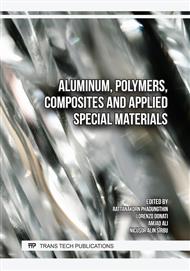[1]
S. Hajra, A.M. Padhan, M. Sahu, P. Alagarsamy, K. Lee, H.J. Kim, Lead-free flexible Bismuth Titanate-PDMS composites: A multifunctional colossal dielectric material for hybrid piezo-triboelectric nanogenerator to sustainably power portable electronics, Nano Energy. 89 (2021) 106316.
DOI: 10.1016/j.nanoen.2021.106316
Google Scholar
[2]
A. Tsyganov, M. Vikulova, I. Zotov, I. Burmistrov, A. Gorokhovsky, N. Gorshkov, Synergistic effect of CaCu3Ti4O12 ceramic and Ti3C2Tx MXene nanoflakes on the dielectric properties of poly (vinylidene fluoride) composites, Materials Chemistry and Physics. 313 (2024) 128714.
DOI: 10.1016/j.matchemphys.2023.128714
Google Scholar
[3]
Q. He, K. Sun, Z. Shi, Y. Liu, R. Fan, Polymer dielectrics for capacitive energy storage: From theories, materials to industrial capacitors, Materials Today. 68 (2023) 298–333.
DOI: 10.1016/j.mattod.2023.07.023
Google Scholar
[4]
Y.M. Poplavko, Chapter 7 - Dielectrics, in: Y.M.B.T.-E.M. Poplavko (Ed.), Elsevier, 2019: p.287–408.
Google Scholar
[5]
G.C. Psarras, 2 - Fundamentals of Dielectric Theories, in: Z.-M.B.T.-D.P.M. for H.-D.E.S. Dang (Ed.), Plastics Design Library, William Andrew Publishing, 2018: p.11–57.
Google Scholar
[6]
N. Sukhawipat, N. Saetung, J.-F. Pilard, S. Bistac, A. Saetung, Synthesis and characterization of novel natural rubber based cationic waterborne polyurethane: Effect of emulsifier and diol class chain extender, Journal of Applied Polymer Science. 135 (2018).
DOI: 10.1002/app.45715
Google Scholar
[7]
N. Sukhawipat, N. Saetung, J.-F. Pilard, S. Bistac, A. Saetung, Effects of molecular weight of hydroxyl telechelic natural rubber on novel cationic waterborne polyurethane: A new approach to water-based adhesives for leather applications, International Journal of Adhesion and Adhesives. 99 (2020).
DOI: 10.1016/j.ijadhadh.2020.102593
Google Scholar
[8]
J. Junthip, N. Chaipalee, Y. Sangsorn, C. Maspornpat, J. Jitcharoen, S. Limrungruengrat, T. Chotchuangchutchaval, E. Martwong, N. Sukhawipat, The Use of New Waste-Based Plasticizer Made from Modified Used Palm Oil for Non-Glutinous Thermoplastic Starch Foam, Polymers. 14 (2022).
DOI: 10.3390/polym14193997
Google Scholar
[9]
C. Quan, N. Miskolczi, S. Feng, P. Grammelis, C. Wu, N. Gao, Effect of type of activating agent on properties of activated carbon prepared from digested solid waste, Journal of Environmental Management. 348 (2023) 119234.
DOI: 10.1016/j.jenvman.2023.119234
Google Scholar
[10]
D.A. Meadows, D.E. Clouse, S. Adhikari, V.A. Davis, Prediction of structural properties of activated carbons derived from lignocellulosic biomass components using mixture design of experiments, Materials Chemistry and Physics. 303 (2023) 127715.
DOI: 10.1016/j.matchemphys.2023.127715
Google Scholar
[11]
M. Zahid, H.M. Khan, M. Zeewaqar Manzoor, H. Ejaz Ahmed, T. Akhter, T. Alshahrani, M. Imran, M.A. Assiri, Optimization of structural, dielectric, and magnetic properties of nanocrystalline copper doped spinel ferrites, Materials Science and Engineering: B. 297 (2023) 116739.
DOI: 10.1016/j.mseb.2023.116739
Google Scholar
[12]
R. Priyadharsini, C. Manoharan, M. Bououdina, S. Sagadevan, M. Venkateshwarlu, S. Asath Bahadur, Impact of nickel substitution on structural, dielectric, magnetic, and electrochemical properties of copper ferrite nanostructures for energy storage devices, Journal of Colloid and Interface Science. 653 (2024) 917–929.
DOI: 10.1016/j.jcis.2023.09.113
Google Scholar
[13]
H. Wang, Y. Yang, L. Yang, Optimization of dielectric loss in calcium copper titanate based on different doping modification strategies, Ceramics International. 49 (2023) 38399–38419.
DOI: 10.1016/j.ceramint.2023.09.186
Google Scholar
[14]
C. Hiranobe, G. Ribeiro, G. Barrera, E. Reis, F. Cabrera, A. Job, L. Paim, R. dos Santos, Cross-Linked Density Determination of Natural Rubber Compounds by Different Analytical Techniques, Materials Research. 24 (2021).
DOI: 10.1590/1980-5373-mr-2021-0041
Google Scholar



